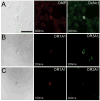Human olfactory epithelial cells generated in vitro express diverse neuronal characteristics
- PMID: 18996445
- PMCID: PMC2951119
- DOI: 10.1016/j.neuroscience.2008.09.059
Human olfactory epithelial cells generated in vitro express diverse neuronal characteristics
Abstract
The olfactory epithelium constitutes the sole source of regenerating neural cells that can be obtained from a living human. As such, primary cultures derived from human olfactory epithelial biopsies can be utilized to study neurobiological characteristics of individuals under different conditions and disease states. Here, using such human cultures, we report in vitro generation of cells that exhibit a complex neuronal phenotype, encompassing receptors and signaling pathways pertinent to both olfaction and other aspects of CNS function. Using in situ hybridization, we demonstrate for the first time the native expression of olfactory receptors in cultured cells derived from human olfactory epithelial tissue. We further establish the presence and function of olfactory transduction molecules in these cells using immunocytochemistry, calcium imaging and molecular methods. Western blot analysis revealed the expression of neurotransmitter receptors for dopamine (D2R), 5-HT (5HT2C) and NMDA subtypes 1 and 2A/2B. Stimulation with dopamine or 5-HT enhanced receptor G protein activation in a subtype specific manner, based on 35S-guanosine triphosphate incorporation assay. Functional characteristics of the cultured cells are demonstrated through enhanced tyrosine phosphorylation of NMDAR 2A/2B and recruitment of signaling partners in response to NMDA stimulation. The array of neuronal characteristics observed here establishes that proliferating cells derived from the human olfactory epithelium differentiate in vitro to express functional and molecular attributes of mature olfactory neurons. These cultured neural cells exhibit neurotransmitter pathways important in a number of neuropsychiatric disorders. Their ready availability from living humans thus provides a new tool to link functional and molecular features of neural cells with clinical characteristics of individual living patients.
Figures







References
-
- Altschul SF, Gish W, Miller W, Myers EW, Lipman DJ. Basic local alignment search tool. Journal of Molecular Biology. 1990;215:403–410. - PubMed
-
- Bonci A, Hopf FW. The dopamine D2 receptor: new surprises from an old friend. Neuron. 2005;47(3):335–338. - PubMed
-
- Buck L, Axel R. A novel multigene family may encode odorant receptors: a molecular basis for odor recognition. Cell. 1991;42765:175–187. - PubMed
-
- Buck LB. Olfactory receptors and odor coding in mammals. Nutr Rev. 2004;62(11 Pt 2):S184–S188. - PubMed
Publication types
MeSH terms
Substances
Grants and funding
LinkOut - more resources
Full Text Sources
Other Literature Sources
Research Materials

